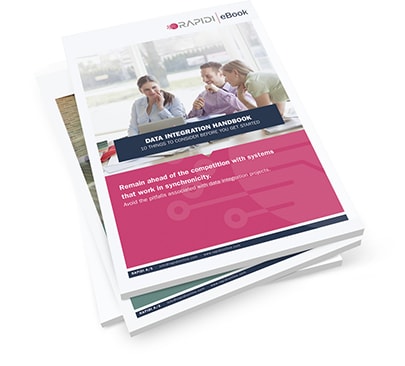Industries are grappling with the challenge of managing vast amounts of data across multiple systems and departments, leading to inefficiencies, inconsistencies, and limited access to real-time information.
The growing complexity of data makes it difficult to perform advanced analytics and derive actionable insights, hindering decision-making and strategic planning.
The adoption of AI and IoT environments exacerbates this issue, with computational constraints affecting the performance and capabilities of AI models and fragmented data sources.
In this article we will explore data integration challenges and solutions. We will delve into how systems like Microsoft Dataverse and the Common Data Model streamline data management across diverse applications, while also addressing the challenges that arise when bridging non-Microsoft systems and highlight how Rapidi offers a flexible, sustainable approach to achieving seamless cross-platform data integration.
The Data Challenge
Data integration solutions can address a myriad of industry challenges by unifying disparate data sources into a single, coherent system. This ensures data consistency, accuracy, and real-time accessibility, facilitating better collaboration and informed decision-making. Additionally, these solutions enable comprehensive analytics by combining diverse data sets, leading to deeper insights and more effective strategies.
With scalability as a key feature, data integration solutions can accommodate the expanding data needs of businesses, breaking data silos and ensuring they remain agile and competitive in an ever-evolving landscape.
Enhancing AI and Edge Device Capabilities
Data integration helps address challenges posed by AI and edge devices by offloading computationally intensive tasks to more powerful systems. It facilitates seamless data synchronization, enabling accurate decision-making in applications like autonomous vehicles or smart manufacturing. Integrated data solutions implement robust security protocols, reducing breaches and safeguarding sensitive information.
They also provide a unified view of the network, enabling easier monitoring of AI model performance and system efficiency. By addressing these challenges, data integration solutions enhance the capabilities of AI and edge devices, ensuring they work harmoniously and effectively within the broader technological ecosystem.
Evolution: From CDS to Microsoft Dataverse
The story started when Microsoft launched its Microsoft Common Data Service (CDS) and then gradually transitioned to Microsoft Dataverse, changing the data integration landscape entirely. Microsoft Dataverse, a cross-platform data integration solution, provides a unified data platform that connects various applications and services. It enables seamless data synchronization and sharing across different environments, such as Dynamics 365, Power Apps, and Azure.
By leveraging Dataverse, organizations can integrate data from multiple sources, ensuring a centralized control system for the multiple data sources which enables consistency and accessibility. This integration supports real-time data updates, enhances collaboration, and facilitates advanced analytics across platforms. Additionally, Dataverse offers connectors and APIs that simplify the process of connecting disparate systems, making it easier to build comprehensive, cross-platform solutions.

Source: Microsoft
Role of the Common Data Model (CDM) in Integration
Then the Microsoft Common Data Model (CDM) came into play, forming another layer over MS Dataverse to simplify cross-platform integration by providing a standardized, extensible data schema that ensures consistency and interoperability across various applications and services. The CDM represents business concepts and activities with well-defined semantics. It provides a common language for business entities, enabling data interoperability across various applications and services.
By using CDM, organizations can ensure that data is consistently structured and understood, regardless of the source or platform. This standardization simplifies data integration, aggregation, and analysis, making it easier to build and maintain applications that rely on shared data. It plays a crucial role in unifying data across CDM Microsoft applications like Dynamics 365, Power Apps, and Azure, facilitating seamless data exchange and enhancing overall data management. Essentially, CDM acts as a shared data language, enabling seamless data exchange and improving the efficiency of data-driven processes.
Limitations of CDM for Cross-Platform Integration
But does this solve the problem? The answer is not entirely. Even with CDM, compatibility is one of the pertinent limitations. When CDM is integrated with non-Microsoft systems, it may require custom connectors or APIs, leading to potential connectivity and data synchronization challenges. Additionally, data transformation may be necessary due to differences in data formats or structures, which can introduce complexity and potential data loss.
The lack of native support for third-party applications may necessitate custom solutions and additional development efforts. Performance overhead is another consideration, particularly when dealing with large data volumes, as this can impact system efficiency and responsiveness. Ensuring data security and compliance can also remain a challenge when integrating with non-Microsoft systems, requiring additional security measures to meet regulatory requirements. Despite these limitations, with the right approach and tools, effective cross-platform integration using CDM is achievable.
Microsoft Dataverse: A Double-Edged Sword
Let us understand how Microsoft Dataverse offers a pinch of salt with its bucket full of sweetness, which can still bring a bitter experience if you are not using the Microsoft ecosystem.

Rapidi: The Cross-Platform Integration Solution
Now, do we need a magic wand to solve these challenges? No. Rapidi will do the trick. It has a significant role to play in cross-platform integration solutions by offering a flexible and user-friendly data integration platform. Being open, the Rapidi solution enables seamless data synchronization between various systems, such as Salesforce, Microsoft Dynamics 365, HubSpot, and more. This solution scales seamlessly as the company expands.
Rapidi's pre-configured best-practice templates and easy-to-use interface with low-code/no-code development make complex integrations simple and fast. This allows businesses to connect disparate systems efficiently, ensuring data consistency and accessibility across platforms. Rapidi provides ongoing support and updates, ensuring an effective customer experience where these integrated systems remain secure and perform optimally.
Additionally, Rapidi takes sustainability seriously in its decision-making. It prioritizes online meetings over travel, reducing carbon costs linked to business travel. It hosts its services over AWS, and aligns with their aims for carbon neutrality by 2025, providing Rapidi’s customers a step toward sustainability.

Advantages of Rapidi Integration
Rapidi's integration capabilities can help businesses achieve streamlined operations, enhanced data consistency, and improved decision-making across various applications and systems as shown in the image below.

Case Studies: Real-Life Success with Rapidi
Let's understand how Rapidi has helped solve real-life problems from the below case studies:
Sea Breeze: Seamless ERP and CRM Integration
Challenge:
Sea Breeze, a family-owned manufacturer and distributor of premium beverages, was hindered by its fragmented approach to customer data management. Customer data was stored across different systems, with critical sales information being manually transferred via Excel spreadsheets. The adoption of Salesforce CRM initially helped streamline data, but it inadvertently doubled the workload. Manual data entry was required to synchronize Salesforce with Microsoft Dynamics NAV, leading to inefficiencies and inaccuracies.
Solution:
Rapidi stepped in with a turnkey solution that automated the integration between Salesforce CRM and Microsoft Dynamics NAV. The result was a fully synchronized data flow, offering complete visibility of customer data. This not only enhanced the efficiency of the sales team but also ensured that field executives and customers received timely, accurate updates.
Impact:
The integration significantly reduced manual errors and data entry time, leading to a more organized system that improved the overall customer experience.
AliMed: Tackling Data Duplication in Healthcare
Challenge:
AliMed, a rapidly expanding healthcare products company, faced persistent issues with duplicate records across its systems. After initially adopting Microsoft CRM 2013 to support its growing sales team, the company encountered data integrity issues that became even more pronounced after switching to Salesforce. Previous integration attempts using solutions like Jitterbit didn’t fully address the problem, leaving AliMed with unreliable data.
Solution:
Rapidi was identified as the answer to these persistent challenges. With its mirroring feature, Rapidi enabled the consolidation of duplicate records into a single, verified record in Salesforce—even without the need for a time stamp. This streamlined approach resolved data quality issues and provided a reliable foundation for analytics on hospital orders.
Impact:
As a result, AliMed witnessed improved data quality, enabling a more accurate analysis of ordering patterns and a refocused sales strategy. The successful integration transformed their Salesforce implementation experience, leading to more strategic business insights.
Conclusion
With over decades of experience, Rapidi has built a strong reputation for delivering effective data integration solutions. It is a competitive option that resolves issues where other solutions reach their limit. By connecting data sources across applications and improving visibility into otherwise overlooked areas,
Rapidi helps uncover lost insights. Beyond a user-friendly, secure, and fast data integration solution, Rapidi can also help you save costs with its tailored pricing plans and effective customer support. Last but not least, it supports sustainability—a critical factor in today’s eco-conscious landscape.














